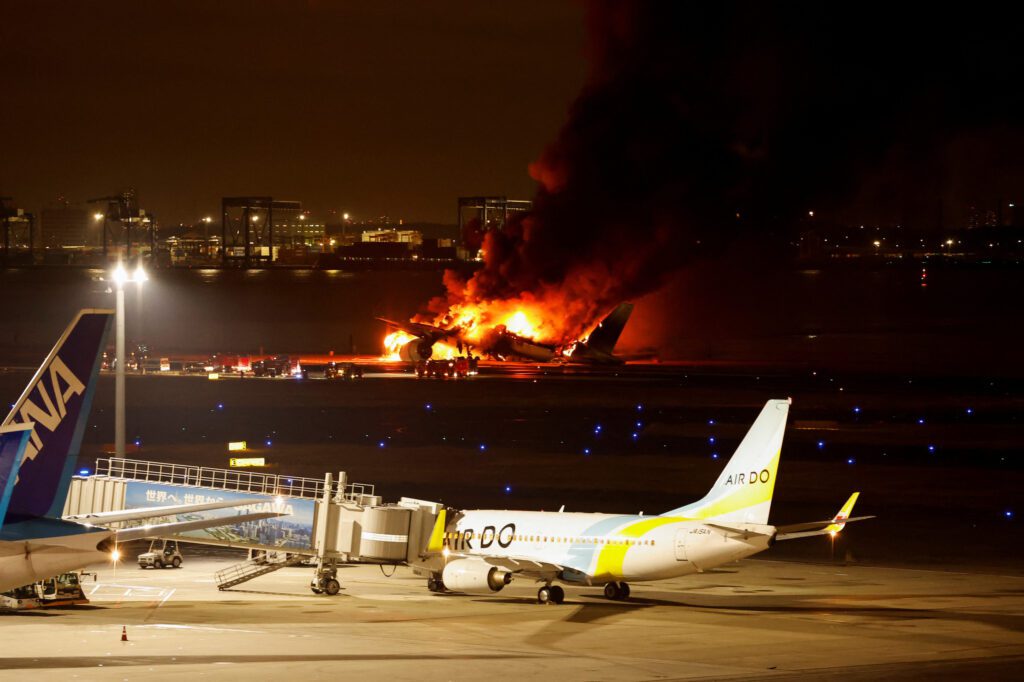[ad_1]

Skift Take
Japan Airlines sees minimal financial impact from Tuesday’s crash in Tokyo, and is even receiving compliments for its safety cutlure.
Japan Airlines expects minimal financial fallout from the the crash of one of its Airbus A350 jetliners at Tokyo’s Haneda Airport on Tuesday. Insurance will cover the cost of the plane while the temporary closure of Haneda’s longest runway is forecast to take a small bite out of the airline’s profits.
“Our main concern is that Haneda Airport is not operating its main runway, Runway C, due to the wreckage of the crashed aircraft,” said Shuei Nishizawa, head of the finance department at JAL, in an analyst call on Thursday. “Therefore, roughly 60 flights to 70 flights, mainly domestic flights, for both JAL and ANA [All Nippon Airways] are cancelled every day now.”
He declined to say how long the runway will remain closed but indicated it will likely be several weeks.
Haneda is the busiest airport in Japan, and an important hub for both ANA and JAL. It is also the main gateway to Japan for a number of foreign carriers, including Air France, American Airlines, British Airways, and Delta Air Lines.
A reduction in flights at Haneda will reduce revenue for JAL and, Nishizawa said, cut into profits. The airline is evaluating the impact on its 2023 fiscal year that ends in March, he added.
JAL previously forecast 1.7 billion Japanese yen ($1.4 billion) in revenue and a 130 million Japanese yen operating profit in the current fiscal year.
A ‘Miracle’ Crash
The crash Tuesday occurred when JAL flight JL516 from Sapporo to Tokyo collided with a Japanese Coast Guard De Havilland Dash 8 upon landing at Haneda at 5:47 p.m. local time. All 367 passengers and 12 crew members aboard the JAL plane survived and evacuated safely. Five of the six aboard the Coast Guard aircraft lost their lives.
Many have described the successful evacuation of all aboard the JAL plane as a “miracle.” It took 18 minutes from touchdown until the last person aboard the aircraft evacuated at about 6:05 p.m. local time, according to the airline.
The A350 was subsequently engulfed in flames. The Coast Guard plane was destroyed upon impact.
Japanese authorities, with assistance from American, British, and French investigators, will lead the investigation into the exact cause of the crash. However, an initial transcript of air traffic control communications with both aircraft suggest that the Coast Guard aircraft taxied onto the runway where the JAL plane was landing without permission.
The Cost of Losing a Plane
The loss of one of JAL’s 16 A350-900s will cost the airline roughly 15 billion Japanese yen ($104 million), it indicated in a stock exchange filing. However, those loses will be fully covered by insurance.
What insurance will not cover is the fact that JAL is down one of its largest aircraft. That is estimated to reduce the airline’s capacity by roughly one percentage point. It will now fly roughly 94% of its pre-pandemic capacity rather than 95%.
To make up for some of that lost capacity, JAL is evaluating whether it can introduce its new A350-1000 earlier than its planned January 24 debut, Nishizawa said. The -1000 is a larger version of the plane involved in the crash Tuesday. Another potential option would be to shift an aircraft planned for cargo flights to passenger flying.
“I think we will be dealing with this over a little more than a year or two,” he said.
JAL’s Reputation Bolstered
“As of now, we have not had many cancellations at all, and in fact a large number of our customers have called us with compliments,” Nishizawa said.
JAL’s safety culture, including its inflight safety briefings and crew preparedness, have widely been lauded in the aftermath of the crash. Both have been cited in the evacuation and survival of all aboard the plane even with only three of the A350’s eight evacuation slides operational and the onboard public address system inoperative.
In addition, Japan’s rule-abiding culture has also been cited in the lack of chaos aboard the plane after it landed and the fact that passengers evacuated without their carry-on luggage.
[ad_2]
Source link

